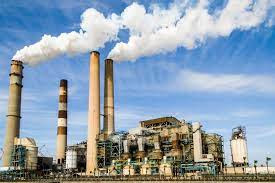Carbon Dioxide
"Carbon Dioxide: The Climate Challenge"
Carbon dioxide, often abbreviated as CO2, is a colorless, odorless gas composed of two oxygen atoms bonded to a single carbon atom. It is a naturally occurring compound found in the Earth's atmosphere, where it plays a crucial role in regulating the planet's temperature and supporting life. Here is a more detailed description of carbon dioxide:

Chemical Composition: Carbon dioxide is a simple chemical compound with the molecular formula CO2. It consists of one carbon (C) atom covalently bonded to two oxygen (O) atoms.
Natural Occurrence: CO2 is naturally present in the Earth's atmosphere, typically making up about 0.04% of the air we breathe. It is also a component of the carbon cycle and is released into the atmosphere through natural processes such as respiration, volcanic eruptions, and decomposition of organic matter.
Greenhouse Gas: Carbon dioxide is a significant greenhouse gas. It has the property of trapping heat from the sun in the Earth's atmosphere, creating a natural greenhouse effect. While this effect is necessary to maintain a habitable temperature on Earth, excessive levels of CO2 due to human activities, such as burning fossil fuels and deforestation, have led to enhanced greenhouse effect and global warming.
Human Activities: Human activities, particularly the burning of fossil fuels (coal, oil, and natural gas) for energy and transportation, have significantly increased the concentration of carbon dioxide in the atmosphere since the Industrial Revolution. This excess CO2 contributes to climate change and is a major driver of global warming.
Impact on Climate: Elevated levels of carbon dioxide in the atmosphere trap more heat, leading to a rise in global temperatures. This phenomenon, known as anthropogenic or human-induced climate change, is associated with a range of environmental impacts, including more frequent and severe heatwaves, sea-level rise, and altered weather patterns.
Carbon Cycle: Carbon dioxide is an integral part of the carbon cycle, which involves the movement of carbon between the atmosphere, land, oceans, and living organisms. It is absorbed by plants during photosynthesis, transferred to animals when they consume plants, and eventually released back into the atmosphere through respiration and decomposition.
Carbon Sequestration: Efforts are underway to mitigate the effects of increased CO2 levels by capturing and storing carbon dioxide emissions from industrial processes (carbon capture and storage) and by promoting the reforestation of forests and other carbon sequestration measures.
In summary, carbon dioxide is a natural component of Earth's atmosphere with a critical role in regulating the planet's climate. However, human activities have led to a significant increase in its concentration, contributing to global warming and climate change. Managing and reducing carbon dioxide emissions is a key focus of environmental efforts to combat climate change.
Carbon dioxide, often abbreviated as CO2, is a colorless, odorless gas composed of two oxygen atoms bonded to a single carbon atom. It is a naturally occurring compound found in the Earth's atmosphere, where it plays a crucial role in regulating the planet's temperature and supporting life. Here is a more detailed description of carbon dioxide:

Chemical Composition: Carbon dioxide is a simple chemical compound with the molecular formula CO2. It consists of one carbon (C) atom covalently bonded to two oxygen (O) atoms.
Natural Occurrence: CO2 is naturally present in the Earth's atmosphere, typically making up about 0.04% of the air we breathe. It is also a component of the carbon cycle and is released into the atmosphere through natural processes such as respiration, volcanic eruptions, and decomposition of organic matter.
Greenhouse Gas: Carbon dioxide is a significant greenhouse gas. It has the property of trapping heat from the sun in the Earth's atmosphere, creating a natural greenhouse effect. While this effect is necessary to maintain a habitable temperature on Earth, excessive levels of CO2 due to human activities, such as burning fossil fuels and deforestation, have led to enhanced greenhouse effect and global warming.
Human Activities: Human activities, particularly the burning of fossil fuels (coal, oil, and natural gas) for energy and transportation, have significantly increased the concentration of carbon dioxide in the atmosphere since the Industrial Revolution. This excess CO2 contributes to climate change and is a major driver of global warming.
Impact on Climate: Elevated levels of carbon dioxide in the atmosphere trap more heat, leading to a rise in global temperatures. This phenomenon, known as anthropogenic or human-induced climate change, is associated with a range of environmental impacts, including more frequent and severe heatwaves, sea-level rise, and altered weather patterns.
Carbon Cycle: Carbon dioxide is an integral part of the carbon cycle, which involves the movement of carbon between the atmosphere, land, oceans, and living organisms. It is absorbed by plants during photosynthesis, transferred to animals when they consume plants, and eventually released back into the atmosphere through respiration and decomposition.
Carbon Sequestration: Efforts are underway to mitigate the effects of increased CO2 levels by capturing and storing carbon dioxide emissions from industrial processes (carbon capture and storage) and by promoting the reforestation of forests and other carbon sequestration measures.
In summary, carbon dioxide is a natural component of Earth's atmosphere with a critical role in regulating the planet's climate. However, human activities have led to a significant increase in its concentration, contributing to global warming and climate change. Managing and reducing carbon dioxide emissions is a key focus of environmental efforts to combat climate change.
#ClimateChange
#CarbonDioxide
#CO2Emissions
#GlobalWarming
#ClimateAction
#CarbonCapture
#ClimateCrisis
#CO2Reduction
#Sustainability
#GreenTech
#CleanEnergy
#ClimateSolutions
#CarbonNeutral
#ClimateScience
#ZeroEmissions
#CarbonDioxide
#CO2Emissions
#GlobalWarming
#ClimateAction
#CarbonCapture
#ClimateCrisis
#CO2Reduction
#Sustainability
#GreenTech
#CleanEnergy
#ClimateSolutions
#CarbonNeutral
#ClimateScience
#ZeroEmissions



Comments
Post a Comment